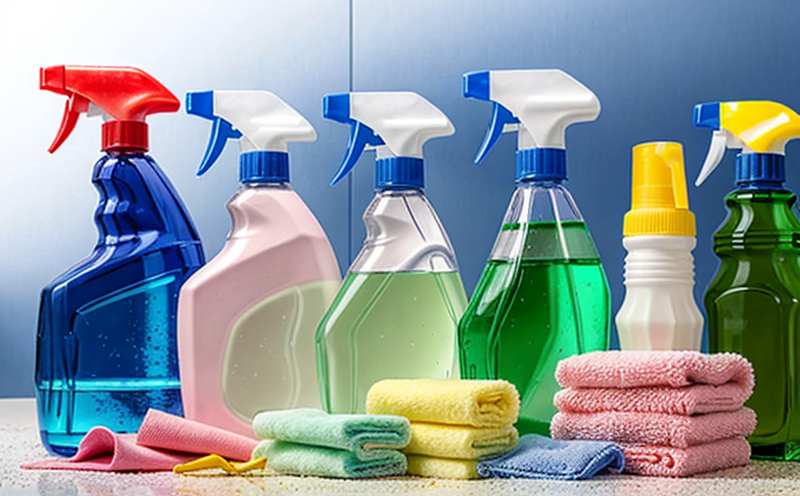Preservative Efficacy Testing in Liquid Cleaners
Preservative efficacy testing is a critical component of product safety and quality assurance. In the context of liquid cleaners, this test ensures that preservatives are effectively inhibiting microbial growth within the formulation. This is particularly important for products like soaps, shampoos, detergents, and other household items where prolonged storage could lead to contamination or degradation.
The primary goal of preservative efficacy testing in liquid cleaners is to verify that a specific preservative can prevent microbiological spoilage over time. The test involves inoculating the product with known microbial strains, allowing it to incubate, and then assessing whether the preservative has been effective in inhibiting growth. This process must be conducted under controlled conditions to ensure accurate results.
Understanding the mechanics of this test requires a look at the specimen preparation and instrumentation used. Specimens are prepared by creating batches of liquid cleaner with varying concentrations of the preservative being tested, alongside control samples without any added preservatives. These specimens are then inoculated with relevant microbial cultures under controlled environmental conditions.
The test apparatus typically includes incubators to maintain constant temperature and humidity levels during the incubation period. Microbiological assays follow established protocols such as those outlined in ISO 6803:2017, which provides guidelines for determining preservative efficacy. After a specified incubation time, the samples are analyzed using appropriate microbiological methods to determine microbial growth.
Accurate and reliable results from this testing are crucial for ensuring consumer safety and product quality. Compliance with international standards like ISO 6803 ensures that tests are conducted consistently across different laboratories worldwide. This consistency is vital for maintaining trust in the products, especially when they are exported to various markets.
The importance of preservative efficacy testing cannot be overstated. It directly impacts consumer safety by preventing potential health risks associated with contaminated products. Moreover, it contributes significantly to reducing waste and ensuring resource efficiency by extending product shelf life without compromising quality.
Real-world applications of this test are numerous. For instance, in the R&D phase, preservative efficacy testing helps identify the optimal concentration of preservatives for a given formulation, balancing effectiveness with consumer safety. In compliance monitoring, it ensures ongoing adherence to regulatory requirements, avoiding potential recalls or legal actions.
Why It Matters
The significance of preservative efficacy testing in liquid cleaners cannot be overstated. This testing ensures that the products meet stringent quality and safety standards set by regulatory bodies worldwide. Compliance with these regulations not only protects consumers but also builds brand reputation and trust.
- Consumer Health: By preventing microbial contamination, this test helps safeguard public health.
- Product Quality: Ensures consistent product performance over time.
- Regulatory Compliance: Avoids non-compliance penalties and potential market bans.
- Economic Benefits: Reduces waste by extending shelf life, thereby optimizing resource usage.
In the context of consumer products, preservative efficacy testing plays a pivotal role in maintaining hygiene standards. It is particularly crucial for products that are frequently used in households or personal care settings where contamination can lead to severe health issues.
The test results from this process provide invaluable data that can be used by quality managers and compliance officers to make informed decisions about product development, manufacturing processes, and market distribution strategies.
Quality and Reliability Assurance
Ensuring the quality and reliability of preservative efficacy testing in liquid cleaners is essential for maintaining high standards within the industry. This involves meticulous adherence to established protocols and rigorous validation procedures. The use of advanced instrumentation, such as incubators and microbiological assay equipment, ensures consistent and accurate results.
The testing process begins with careful specimen preparation, involving the creation of batches with varying concentrations of preservatives. These specimens are then inoculated with known microbial strains under controlled conditions to simulate real-world scenarios accurately. The samples are incubated over a specified period, during which time any changes in microbial growth are meticulously recorded.
The results from these tests are analyzed using statistical methods to determine the efficacy of the preservative. Compliance with international standards like ISO 6803:2017 ensures that all testing procedures follow best practices and produce reliable outcomes. This consistency is critical for maintaining trust in the products, especially when they are sold internationally.
The data generated from this testing is crucial for quality managers and compliance officers. It provides insights into product performance, helping to identify areas for improvement and ensuring ongoing adherence to regulatory requirements. By leveraging these results, companies can make informed decisions about product development, manufacturing processes, and market distribution strategies.
Environmental and Sustainability Contributions
- Eco-Friendly Packaging: The testing process itself does not contribute directly to environmental issues. However, the use of eco-friendly packaging for product samples can reduce waste and promote sustainability.
- Resource Efficiency: By extending the shelf life of products through effective preservative efficacy testing, resources are used more efficiently, reducing the need for frequent replacements or new production runs.
- Reduction in Contamination Risks: Preventing microbial contamination not only ensures product quality but also reduces the likelihood of waste from contaminated batches.
The focus on preservative efficacy testing contributes positively to sustainable practices by ensuring that products remain safe and effective over extended periods. This, in turn, helps minimize resource use and supports a circular economy model.





